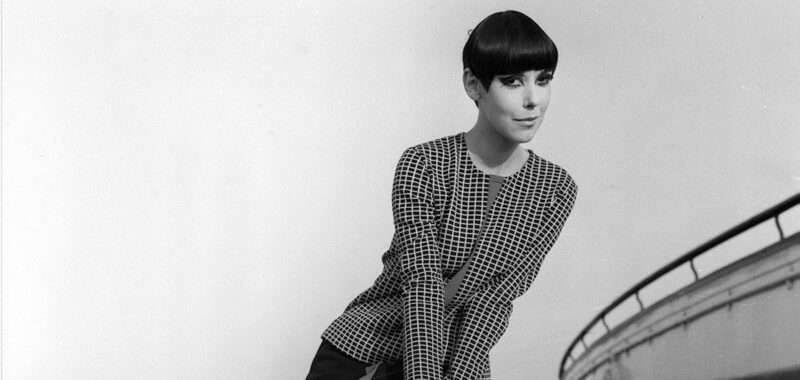Peggy Moffitt, the American model and actress known for her avant-garde signature style, died on Saturday, August 10 in Beverly Hills at the age of 87 following a long illness. The news was confirmed by her son, Christopher Claxton. An icon of the Swinging Sixties, Moffitt will be remembered for her five-point haircut by Vidal Sassoon, her unique eye makeup—which she created herself, and her collaborative efforts with designer Rudi Gernreich.
Born in Los Angeles as Margaret Anne Moffitt on May 14, 1940, Peggy was raised in the California city and attended the Marlborough School in Hancock Park. She later went on to study acting at the Neighborhood Playhouse in New York City under instructors like Sydney Pollack and alongside fellow students including Robert Duvall. In 1955, she landed her first acting job, an uncredited role in the musical-comedy, You’re Never Too Young.
Moffitt wearing a Rudi Gernreich design in 1967.
Ben Martin/Archive Photos/Getty Images

Moffitt was also trained in ballet, which influenced her modeling style. It was a shared interest in dance that first connected Moffitt to Rudi Gernreich, whom she met in 1954 when she was still in high school and working at the Beverly Hills boutique Jax. “They hit it off and had a lot in common,” Christopher Claxton told WWD. “They approached art and design in a similar way and had a big appreciation for dance and humor in design.”
In 1958, Moffitt met photographer William Claxton, who inspired the then-18-year-old to try her hand at modeling. The two married a year later, and eventually welcomed their son, Christopher, in 1973.
Together, Moffitt, Gernreich, and Claxton became a sort of trio. In 1961, they produced “Basic Black: William Claxton w/Peggy Moffitt,” considered the first fashion film. “They all inspired each other, and there was a synergistic effect between them, especially with Rudi. Every time he needed to get photos done, he called my father,” Christopher said. Moffitt has often been described as Gernreich’s muse. “Without Rudi, I would have been a gifted and innovative model. Without me, he would have been an avant-garde designer of genius. We made each other better. We were each other’s catalyst,” Moffitt said in The Rudi Gernreich Book. “It was fun, it was invigorating, it was a true collaboration, and yes, it was love.”
Moffitt modeling a piece from Gernreich’s spring/summer 1968 collection with Gernreich behind her.
WWD/Penske Media/Getty Images

Gernreich’s most notable creation, the monokini, became international news when Women’s Wear Daily published a topless image of Moffitt in the design in 1964. The bathing suit was not intended for production, more so a social statement on women’s liberation. “It was an exaggeration that had to do with setting women free,” Moffitt said in 1985. “It had nothing to do with display, and the minute someone wears it to show off her body, you’ve negated the entire principle of the thing.”
The image would go on to define her career, something Moffitt had mixed feelings about. “Think of something in your life that took one-sixtieth of a second to do,” she said in 2012. “Now, imagine having to spend the rest of your life talking about it. I think it’s a beautiful photograph, but oh, am I tired of talking about it.” Moffitt would go on to star in many other ground-breaking projects, including cult fashion films like 1962’s Blow-Up and Who Are You, Polly Maggoo in 1966.
Jill Kennington, Peggy Moffit, Rosaleen Murray, Ann Norman and Melanie Hampshire on the set of Blow-Up alongside David Hemmings in 1966.
Michael Ochs Archives/Moviepix/Getty Images

Moffitt’s mod aesthetic continues to influence to this day, though, in recent years, the model expressed her disinterest in contemporary fashion. “Fashion fell off a long time ago,” she told WWD in 2016. “I can’t tell you to the minute that it died. Probably when everybody started wearing pants. Fashion is really dead except for…dream occasions or fantasy.” That being said, Moffitt did try her hand at designing in her later years. In 2003, she worked with Comme des Garçons on a collection of T-shirts and reinterpretations of Gernreich designs and in 2016 she launched a leisurewear label with the help of designer Evelina Galli.
Moffitt will be remembered for the image of the monokini, of course, but also her mod style, her unique, expressive form of modeling, her graphic makeup, and the collaborations that helped to define her career.

